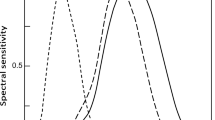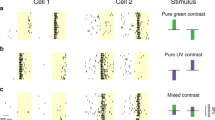Abstract
In the 1950s De Valois and colleagues, followed by other researchers, discovered spectrally opposed single cells in the primate LGN. They called them Red-Green and Yellow-Blue opponent colour cells, interpreting them as the biological implementation of Hering’s opponent colours theory. By the 1990s, it became increasingly clear the growing data on such cells did not match Hering’s unique hues Red-Green, Yellow-Blue. Yet these cells today remain misleadingly described by opponent-colour or similar various terms, with no agreed best term. This paper reviews much of the data to show spectrally opposed responses in primate retina, LGN, and striate cortex are complementary colours of three types: Blue-Yellow, Red-Cyan, and (less often) Green-Magenta. Such cells may be termed ‘complementary colour cells’ as a generic category, and further specified by the respective hue pair, e.g. Red-Cyan. (In psychophysics, ‘complementary colours’ refers to a pair of colour stimuli that admix white.) The difference between opponent colours and complementary colours is more than semantic: it concerns colour constancy, which in theory is aided by complementary colour cells.




Similar content being viewed by others
References
G. Svaetichin, Spectral response curves from single cones. Acta. Physiol. Scand. 39(Suppl. 134), 19–46 (1956)
G. Svaetichin, E.F. MacNichol Jr., Retinal mechanisms of chromatic and achromatic vision. Ann. N.Y. Acad. Sci. 74, 385–404 (1958)
E. Hering, Zur Lehre vom Lichtsinne (Carl Gerold’s Sohn, Wien, 1878). A theory of the light sense
D. Jameson, L.M. Hurvich, Some quantitative aspects of an opponent colors theory. I. Chromatic responses and spectral saturation. J. Opt. Soc. Am. 45, 546–552 (1955)
L.M. Hurvich, D. Jameson, Some quantitative aspects of an opponent colors theory. II. Brightness, saturation and hue in normal and dichromatic vision. J. Opt. Soc. Am. 45, 602–616 (1955)
R.L. De Valois, C.J. Smith, S.T. Kital, A.J. Karoly, Response of single cells in monkey LGN to monochromatic light. Science 127, 238–239 (1958)
T.N. Wiesel, D.H. Hubel, Spatial and chromatic interactions in the lateral geniculate body of the rhesus monkey. J. Neurophysiol. 29, 1115–1156 (1966)
H.G. Wagner, E.F. MacNichol Jr., M.L. Wolbarsht, Opponent color responses in retinal ganglion cells. Science 13, 1314 (1960)
K.I. Naka, W.A.H. Rushton, S-potentials from colour units in the retina of fish (cyprinidae). J. Physiol(London) 185, 536–555 (1966)
N.W. Daw, Goldfish retina: organisation for simultaneous color contrast. Science 158, 942–946 (1967)
A.L. Byzov, Y.A. Trifonov, The response to electrical stimulation of horizontal cells in the carp retina. Vis. Res. 8, 817–822 (1968)
P. Gouras, E. Zrenner, Color coding in the primate retina. Vis. Res. 21, 1591–1598 (1981)
K. Fukurotani, Color information coding of horizontal-cell responses in fish retina. Color. Res. Appl. 7, 146–148 (1982)
J.-I. Toyoda, M. Fujimoto, Analysis of neural mechanisms mediating the effect of horizontal cell polarization. Vis. Res. 23, 1143–1150 (1983)
A.M. Derrington, J. Krauskopf, P. Lennie, Chromatic mechanisms in the lateral geniculate nucleus of macaque. J. Physiol(London) 357, 241–265 (1984)
T.E. Ogden, G.G. Mascetti, R. Pierantoni, The outer horizontal cell of the frog retina: morphology, receptor input, and function. Invest. Ophthalmol. Vis. Sci. 26, 643–656 (1985)
V.I. Govardoskii, A.L. Byzov, L.V. Zueva, N.A. Polisczuk, E.A. Baburina, Spectral characteristics of photoreceptors and horizontal cells in the retina of the Siberian sturgeon Acipenser baeri brandt. Vis. Res. 27, 179–189 (1991)
R.C. Reid, R.M. Shapley, Spatial structure of cone inputs to receptive fields in primate lateral geniculate nucleus. Nature 356, 716–718 (1992)
M.J.M. Lankheet, P. Lennie, J. Krauskopf, Distinctive characteristics of subclasses of red–green P-cells in LGN of macaque. Vis. Neurosci. 15, 37–46 (1998)
C.R. Michael, Color vision mechanisms in monkey striate cortex: dual-opponent cells with concentric receptive fields. J. Neurophysiol. 41, 572–588 (1978)
M.S. Livingstone, D.H. Hubel, Anatomy and physiology of a color system in the primate visual cortex. J. Neurosci. 4, 309–356 (1984)
P. Lennie, J. Krauskopf, G. Sclar, Chromatic mechanisms in striate cortex of macaque. J. Neurosci. 10, 649–669 (1990)
B. Conway, Spatial structure of cone inputs to color cells in alert macaque primary visual cortex (V-1). J. Neurosci. 21, 2768–2783 (2001)
F. Ratliff, On the psychophysiological bases of universal color terms. Proc. Am. Philos. Soc. 120, 311–330 (1976)
S.L. Guth, Model for color vision and light adaptation. J. Opt. Soc. Am. A. 8, 976–993 (1981)
E. Kaplan, B.B. Lee, R.M. Shapley, New views of primate retinal function. Prog. Retin. Res. 9, 273–336 (1990)
R.L. De Valois, K.K. De Valois, A multi-stage color model. Vis. Res. 33, 1053–1065 (1993)
K. Jameson, R.G. D’Andrade, It’s not really red, green, yellow, blue: an inquiry into perceptual color space, in Color categories in thought and language, ed. by C.L. Hardin, L. Maffi (University of Cambridge Press, Cambridge, 1997), pp. 295–319
Gouras P. Color Vision, in Webvision, Organisation of Retina And Visual System, Kolb H, Fernandez E, Nelson R, eds, 1999; http://www.webvision.med.utah.edu.
M.A. Webster, E. Miyahara, G. Malkoc, V.E. Raker, Variations in normal color vision. II. Unique hues. J. Opt. Soc. Am. 17, 1545–1555 (2000)
A. Valberg, Unique hues: an old problem for a new generation. Vis Research 41, 1645–1657 (2001)
B.R. Conway, M.S. Livingstone, A different point of hue. Proc. Natl. Acad. Sci. USA 102, 10761–10762 (2005)
J. Krauskopf, D.R. Williams, D.W. Heeley, Cardinal directions of color space. Vis. Res. 22, 1123–1131 (1982)
S.M. Wuerger, P. Atkinson, S. Cropper, The cone inputs to the unique-hue mechanisms. Vis. Res. 45, 3210–3223 (2005)
Newton I. Opticks. London: Walford B and Walford S, printers to the Royal Society; 1704.
Maxwell JC. Experiments on colour, as perceived by the eye, with remarks on colour blindness. Philos Trans R Soc Edinburgh 1854–1855;21(Part 2):275–298.
M.E. Chevreul, De la loi du contraste simultane des couleurs (Pitois-Levraux, Paris, 1839)
G.A. Agoston, Color theory and application in art and design (Springer, London, 1987)
B. Berlin, P. Kay, Basic color terms: Their universality and evolution (University of California Press, Berkeley, 1969)
R.G. Kuehni, Variability in unique hue selection: a surprising phenomenon. Color. Res. Appl. 29, 158–162 (2004)
R.W. Pridmore, Unique and binary hues as functions of luminance and illuminant color temperature, and relations with invariant hues. Vis. Res. 39, 3892–3908 (1999)
E.H. Land, J.J. McCann, Lightness and retinex theory. J. Optical Soc. Am. 61, 1–11 (1971)
O.D. Creutzfeldt, J.M. Crook, S. Kastner, C.Y. Li, X. Pei, The neurophysiological correlates of colour and brightness contrast in lateral geniculate neurons. I. Population analysis. Exp. Brain Res. 87, 3–21 (1991)
S. Kastner, J.M. Crook, X. Pei, O.D. Creutzfeldt, Neurophysiological correlates of colour induction on white surfaces. Eur. J. Neurosci. 4, 1079–1086 (1992)
R.L. De Valois, Color vision mechanisms in the monkey. J. Gen. Physiol. 43, 115–128 (1960)
D.A. Baylor, B.J. Nunn, J.L. Schnapf, Spectral sensitivity of cones of the monkey Macaca fascicularis. J. Physiol. 390, 145–160 (1987)
R.L. De Valois, H.C. Morgan, M.C. Polson, W.R. Mead, E.M. Hull, Psychophysical studies of monkey vision. I. Macaque luminosity and color vision tests. Vision Res 14, 53–67 (1974)
J.H. Sandell, C.G. Gross, M.H. Bornstein, Color categories in macaques. J. Comp. Physiol. Psychol. 93, 626–635 (1979)
R.C. Reid, R.M. Shapley, Space and time maps of cone photoreceptor signals in macaque lateral geniculate nucleus. J. Neurosci. 22, 6158–6175 (2002)
E.N. Johnson, M.J. Hawken, R. Shapley, Cone inputs in macaque primary visual cortex. J. Neurophys. 91, 2501–2514 (2004)
G.D. Horwitz, E.J. Chichilnisky, T.D. Albright, Cone inputs to simple and complex cells in V1 of awake macaque. J. Neurophys. 97, 3070–3081 (2007)
S.G. Solomon, P. Lennie, Chromatic gain controls in visual cortical neurons. J. Neurosci. 25, 4779–4792 (2005)
B. Conway, D. Hubel, M.S. Livingstone, Color contrast in macaque V1. Cereb. Cortex 12, 915–925 (2002)
B.R. Conway, M.S. Livingstone, Spatial and temporal properties of cone signals in alert Macaque primary visual cortex. J. Neuroscience 26, 10826–10846 (2006)
C. Tailby, S.G. Solomon, N.T. Dhruv, P. Lennie, Habituation reveals fundamental chromatic mechanisms in striate cortex of macaque. J. Neurosci. 28, 1131–1139 (2008)
J.D. Victor, E.M. Blessing, J.D. Forte, P. Buzas, P.R. Martin, Response variability of marmoset parvocellular neurons. J. Physiol. 579, 29–51 (2007)
P.A. Dufort, C.J. Lumsden, Color categorization and color constancy in a neural network model of V4. Biol. Cybern. 65, 293–303 (1991)
K.R. Gegenfurtner, Cortical mechanisms of colour vision. Nat. Neurosci. 4, 563–572 (2003)
R.W. Pridmore, Theory of corresponding colors as complementary sets. Color. Res. Appl. 30, 371–381 (2005)
R.W. Pridmore, Color constancy from invariant wavelength ratios: I. The empirical spectral mechanism. Color. Res. Appl. 33, 238–249 (2008)
R.W. Pridmore, Complementary colors: the structure of wavelength discrimination, uniform hue, spectral sensitivity, saturation, chromatic induction and adaptation. Color. Res. Appl. 34, 233–252 (2009)
M. Pottek, K. Schultz, R. Weiler, Effects of nitric oxide on the horizontal cell network and dopamine release in the carp retina. Vis. Res. 37, 1091–1102 (1997)
G. Twig, H. Levy, I. Perlman, Color opponency in horizontal cells of the vertebrate retina. Prog. Retin. Eye Res. 22, 31–68 (2003). Review article
K.R. Gegenfurtner, J. Rieger, Sensory and cognitive contributions of color to the recognition of natural scenes. Curr. Biol. 10, 805–808 (2000)
F.A. Wichmann, L.T. Sharpe, K.R. Gegenfurtner, The contributions of color to recognition memory for natural scenes. J. Exp. Pyschol. Learn. Mem. Cognit. 28, 509–520 (2002)
M.H. Brill, G. West, Contributions to the theory of invariance of color under the condition of varying illumination. J. Math. Biol. 11, 337–350 (1981)
L.T. Maloney, B. Wandell, Color constancy: a method for recovering surface spectral reflectance. J. Opt. Soc. Am. A. 3, 29–33 (1986)
M.H. Brill, Color constancy and color rendering: concomitant engineering of illuminants and reflectances. Color. Res. Appl. 13, 174–180 (1988)
G.D. Finlayson, M.S. Drew, B.V. Funt, Color constancy: generalized diagonal transforms suffice. J. Opt. Soc. Am. A. 11, 3011–3020 (1994)
Kries J von, Chromatic adaptation. (Festschrift der Albrecht-Ludwig Universtat, 1902)
S.M. Courtney, L.H. Finkel, G. Buchsbaum, Network simulations of retinal and cortical contributions to color constancy. Vis. Res. 35, 413–434 (1994)
D.H. Foster, S.M.C. Nascimento, Relational color constancy from invariant cone-excitation ratios. Proc. R. Soc. Lond. B. Biol. Sci. 257, 115–121 (1994)
D.H. Hubel, Eye, Brain and Vision, 2nd edn. (Scientific American Library, New York, 1995)
K. Moutoussis, S. Zeki, Responses of spectrally selective cells in macaque area V2 to wavelengths and colors. J. Neurophys. 87, 2104–2112 (2002)
T. Wachtler, T.J. Sejnowski, T.D. Albright, Representation of color stimuli in awake macaque primary visual cortex. Neuron 37, 681–691 (2003)
Buchsbaum G, Tailor DR. The elementary structure of natural color images and its possible neurophysiological correlates [Abstract]. Journal of Vision 1(3) (2001): doi:10.1167/1.3.64
J. Larimer, D.H. Krantz, C.M. Cicerone, Opponent-process additivity. I. Red/green equilibria. Vis. Res. 14, 1127–1140 (1974)
J. Larimer, D.H. Krantz, C.M. Cicerone, Opponent-process additivity. II. Yellow/blue equilibria. Vis. Res. 18, 723–731 (1975)
R.W. Pridmore, Complementary colors theory of color vision: physiology, color mixture, color constancy, and color perception. Color. Res. Appl. 36, 394–412 (2011)
Acknowledgments
I thank Dr. Bevil Conway, Wellesley College, Massachusetts, USA, for advice on many physiological aspects of the manuscript.
Author information
Authors and Affiliations
Corresponding author
Rights and permissions
About this article
Cite this article
Pridmore, R.W. Single cell spectrally opposed responses: opponent colours or complementary colours?. J Opt 42, 8–18 (2013). https://doi.org/10.1007/s12596-012-0090-0
Received:
Accepted:
Published:
Issue Date:
DOI: https://doi.org/10.1007/s12596-012-0090-0




